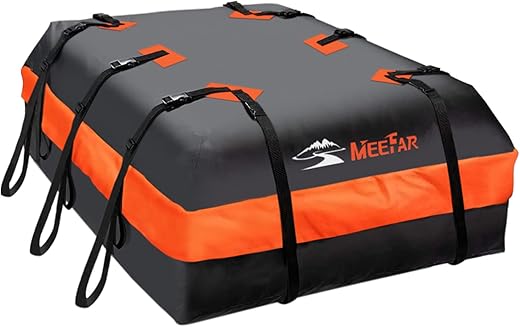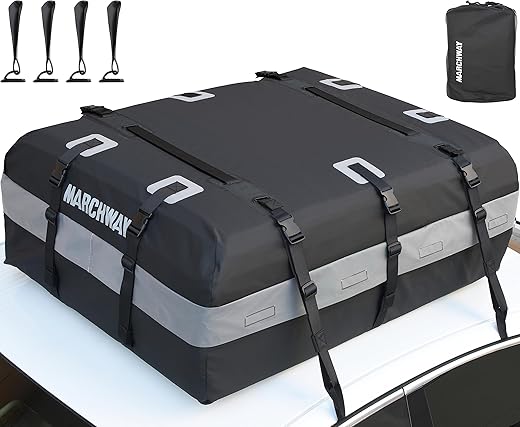Are roof racks noisy when driving?
As a car owner and outdoor enthusiast, I understand the excitement of hitting the open road with adventure gear securely packed on a roof rack. However, I also know that concerns about noise and its impact on driving comfort can be a significant factor when considering whether to invest in one. In this blog post, I aim to address the common question: Are roof racks noisy when driving? Together, we will explore how roof racks can affect road noise, fuel efficiency, and your overall driving experience, ensuring you have all the information you need to make an informed decision for your journeys ahead.



Understanding Roof Racks
When it comes to maximizing the utility of your vehicle, roof racks are a game-changer. They not only add storage space but also enhance the versatility of your car for various outdoor adventures, from camping trips to weekend sports activities.
What Are Roof Racks?
Roof racks are external frameworks mounted on the roof of a vehicle to carry additional cargo. Typically composed of strong materials such as aluminum or steel, they are designed to secure your gear firmly while traveling. Roof racks come in various configurations, allowing users to customize the setup based on their needs.
The Purpose of Roof Racks
The primary purpose of roof racks is to increase the carrying capacity of your vehicle. Whether you’re heading off for a weekend getaway or simply need extra room for your sports gear, a roof rack makes transporting cumbersome items easier. Here are some of the main functions of roof racks:
- Additional Storage Space: They free up interior space by allowing you to transport luggage, camping gear, or sports equipment outside.
- Versatility: Different attachments can be used with roof racks, such as bike carriers, kayak holders, or cargo boxes.
- Easy Access: Roof racks can simplify loading and unloading items with the right accessories.
Types of Roof Racks
There are several types of roof racks available on the market, each designed for specific uses. Here’s a breakdown:
- Crossbars: Basic horizontal bars installed on the roof rails of a vehicle. Popular models include the Thule AeroBlade Edge and Yakima JetStream, known for their aerodynamic design that minimizes wind noise.
- Cargo Baskets: These racks feature a mesh floor and side rails for securing loads. The Rhino-Rack Pioneer Platform is an excellent example that offers ample space for larger items.
- Cargo Boxes: Aerodynamically designed boxes that attach to roof racks, providing enclosed storage for luggage. The Thule Motion XT is a top choice, offering easy access and ample storage space.
- Ski and Snowboard Racks: Specifically designed to carry winter sports gear, the Yakima FatCat 6 allows easy loading and unloading of skis and snowboards while keeping them secure.
Materials Used in Roof Racks
The materials used in roof racks often impact their durability and noise levels. Most roof racks are constructed from:
- Aluminum: Lightweight yet strong, aluminum racks are resistant to rust and corrosion but may carry a cost premium. The Thule AeroBlade line is made of aluminum and is highly regarded for its performance.
- Steel: While heavier, steel racks are extremely durable and can handle more weight. The Curt 18115 is a solid option for those needing robust support for heavy loads.
Impact on Noise Levels
One often overlooked aspect of roof racks is their impact on noise during driving. Aerodynamic designs help minimize wind resistance and reduce noise levels significantly. For instance:
| Roof Rack Type | Noise Level | Aerodynamics | Example Models |
|---|---|---|---|
| Crossbars | Moderate | High | Thule AeroBlade, Yakima JetStream |
| Cargo Baskets | High | Moderate | Rhino-Rack Pioneer Platform |
| Cargo Boxes | Low | Very High | Thule Motion XT |
| Ski/Snowboard Racks | Moderate | High | Yakima FatCat 6 |
Investing in roof racks designed with low wind resistance can lead to a quieter and more enjoyable driving experience.
Practical Examples of Roof Racks in Action
Imagine a family of four planning a road trip. Rather than squeezing everything inside the vehicle, they opt for a Yakima LoadWarrior cargo basket, securing their luggage, camping gear, and beach supplies easily on the roof. Additionally, for family members who love skiing, attaching a Thule SnowPack ski rack allows them to transport their gear safely without sacrificing interior space.
In conclusion, choosing the right roof rack can significantly enhance your vehicle’s utility, opening up a world of possibilities for outdoor adventures and daily travel. By understanding the types, materials, and potential noise levels, you can make an informed decision that caters to your specific needs.
Factors Affecting Noise Levels
When it comes to driving with a roof rack, noise levels can vary significantly based on various factors. Understanding these elements will not only help you make informed purchasing decisions but also enhance your overall driving experience. Let’s explore the primary contributors to noise levels while using a roof rack.
Type of Roof Rack: Permanent vs. Removable
Permanent Roof Racks
Permanent roof racks are typically more integrated into the vehicle’s design. They can offer a cleaner and sleeker appearance, but due to their fixed nature, they can create a consistent drag that leads to higher noise levels over time. For example, Thule Evo Flush Rail roof racks provide a stylish and aerodynamic option but may still produce noticeable wind noise at higher speeds.
Removable Roof Racks
Removable roof racks, on the other hand, are often designed for easy installation and removal. While they can be quieter during non-use, they may generate additional noise when affixed to the vehicle. The Yakima Jetstream, for example, features an aerodynamic shape that helps mitigate wind noise despite being removable.
Comparison of Noise Levels
| Feature | Permanent Roof Racks | Removable Roof Racks |
|---|---|---|
| Noise at High Speeds | Typically higher | Variable, often lower |
| Installation | Fixed and stable | Flexible installation |
| Aesthetic Appeal | Integrated design | Can be removed for a cleaner look |
Materials Used in Roof Racks
The materials used in the construction of a roof rack can significantly affect noise levels.
- Aluminum Racks: Generally lighter and more aerodynamic, aluminum racks like the Thule Aeroblade tend to produce less noise due to their smooth surfaces.
- Steel Racks: Heavier and often more rugged, steel racks, such as the Rhino-Rack Heavy-Duty, can increase overall noise levels due to their bulkier profile and increased wind resistance.
Material Impact Example
- Thule Aeroblade (Aluminum): Known for its low-noise design and great fuel efficiency due to its aerodynamic shape.
- Rhino-Rack Heavy-Duty (Steel): Offers strength and durability but may create more wind turbulence, resulting in increased noise levels.
Aerodynamic Design
The aerodynamic design of the roof rack plays a critical role in reducing noise. Racks designed with wind resistance in mind will produce less turbulence and, subsequently, less noise.
Features of Aerodynamic Roof Racks
- Sleek Profile: Roof racks like the Yakima Skyline feature a sleek, narrow profile that works to slice through the air, reducing noise.
- Wind Fairings: Many roof racks come equipped with wind fairings, which are designed to redirect airflow. The Thule Fairing is a great accessory that minimizes wind noise, especially at highway speeds.
| Roof Rack Model | Aerodynamic Features | Noise Level Reduction |
|---|---|---|
| Yakima Skyline | Sleek profile, built-in fairings | Low |
| Thule Evo Flush Rail | Smooth edges, integrated design | Moderate |
| Rhino-Rack Heavy-Duty | Bulky design | Higher |
Load Being Carried
The type and weight of the load carried on the roof rack can also affect noise levels. Heavier or bulkier loads tend to create more wind resistance, leading to an increase in noise.
Examples of Loads and Their Impact
- Bicycles: Carrying a couple of bicycles using the Thule ProRide Bike Carrier can lead to noticeable noise due to the shape and positioning of the bikes.
- Cargo Boxes: Boxes like the Yakima SkyBox can provide significant storage but may cause increased drag and related noise.
Load Impact Considerations
- Light Loads: Minimal noise impact; best for items like snowboard racks or ski carriers.
- Heavy or Awkward Loads: More pronounced noise at highway speeds; bikes and cargo boxes can elevate noise levels.
Vehicle Make and Model Variations
It’s important to recognize that different vehicles will experience varied noise levels due to their design, aerodynamics, and overall body shape.
Vehicle Examples
- SUVs: Models like the Jeep Grand Cherokee may experience higher noise levels due to their boxy shapes and higher seating positions, especially when carrying larger loads.
- Sedans: Cars such as the Honda Accord typically have better aerodynamics, resulting in less noise when equipped with a roof rack.
Vehicle Comparison Summary
| Vehicle Type | Common Models | Expected Noise Level |
|---|---|---|
| SUVs | Jeep Grand Cherokee, Toyota 4Runner | Moderate to High |
| Sedans | Honda Accord, Toyota Camry | Low to Moderate |
| Hatchbacks | Ford Focus, Volkswagen Golf | Low |
By understanding these factors—ranging from the type of roof rack, to the materials used, aerodynamic designs, the loads being carried, and the specific vehicle in use—you can make better choices that will minimize noise while driving with a roof rack.
Final Thoughts on Roof Rack Noise
In conclusion, I hope to clarify that while roof racks can indeed generate some noise while driving, the level of that noise is influenced by several factors such as the design of the rack, the type of vehicle, and the accessories used. It’s essential for potential buyers to carefully consider their specific needs, ensure compatibility with their vehicle, and choose appropriate accessories that can help minimize noise. By doing so, they can enhance their driving experience while making the most of their roof rack.




12 comments